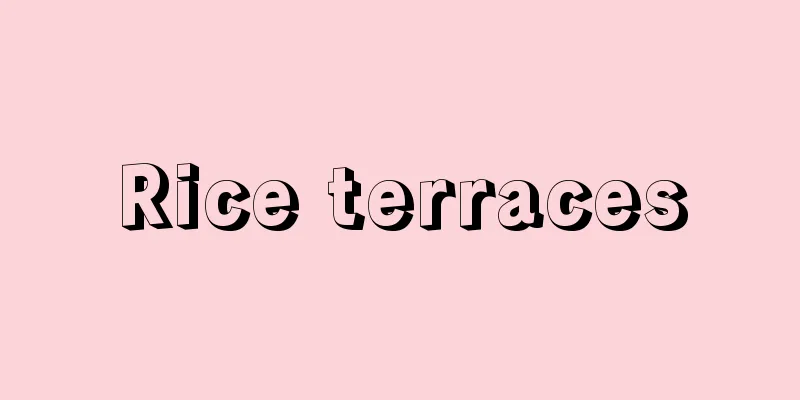Rice terraces

|
A terraced rice field built on steep slopes such as mountainside. In mountainous areas, where even steep land has been cultivated, the rice fields are narrow strips with fairly high vertical walls built between the upper and lower rice fields, which are maintained with stones and other materials, giving them the appearance of shelves. Rice terraces are built along contour lines, so they are a type of terrace cultivation. They are also called Senmaida because of the many small rice terraces built on mountainsides. Cultivating rice terraces requires a lot of labor to transport agricultural tools, fertilizer, and materials, and it is difficult to mechanize the cultivation, so it must be done mainly by hand. Water can only be provided by irrigating each rice field with rainwater, or by small springs and reservoirs. In valley-shaped rice terraces in highland areas, snow melts slowly in the spring, so the water temperature does not rise, and frost falls early in the fall, so the high temperature period suitable for rice cultivation is short. Furthermore, rice terraces are made of volcanic ash soil with a lot of gravel, and many of the cultivated soil is shallow and leaks easily. Cold water irrigation is used here, so the fields are prone to cold damage when the extremely low temperatures hit in July and August during the height of summer. In years with little rainfall, they are also prone to drought damage. As such, rice terraces are economically disadvantaged because of the unstable growth and low productivity of the crops. In Japan, terraced rice fields are particularly common in the Chubu region, at altitudes of 500 meters or more, and can also be found on the coasts of islands with little flat land. Rice terraces are not only found in Japan, but also in many parts of Southeast Asia, including the Philippines and Taiwan, and have developed on a large scale in the highlands of Yunnan Province in China. [Hoshikawa Kiyochika] [Reference] |The terraced rice fields spread across the slopes at the foot of Mt. Obasute (Mt. Kanmuritake), known for the legend of Mt. Obasute. The moon's reflection on the rice fields has long been known as the "Tagoto no Tsuki" (the moon reflected in the rice fields), and has been the subject of many waka and haiku poems. Nationally designated Place of Scenic Beauty Chikuma City, Nagano Prefecture © Shinshu-Nagano Prefecture Tourism Association "> Obasute rice terraces The rice terraces were created by cutting into the slopes facing the Sea of Japan in Shiroyone-cho, Wajima City. Small rice fields spread out in a stepped pattern, and there are more than 2,000 of them (1,004 in the nationally designated area). It is registered as a Globally Important Agricultural Heritage Site. Nationally Designated Place of Scenic Beauty Wajima City, Ishikawa Prefecture © Hotto Ishikawa Travel Net "> Shiroyone's rice fields These rice terraces spread across the southwestern slope of Mt. Shirakura in the Maruyama district of Kumano City. It is said that there were 2,240 rice fields in 1601 (Keicho 6), but since the 1960s, the number has decreased to around 500. However, thanks to restoration and conservation efforts by local residents that began in 1993 (Heisei 5), the number of rice terraces has now increased to over 1,300. Kumano City, Mie Prefecture © Mie Prefecture Tourism Association "> Maruyama Senmaida Source: Shogakukan Encyclopedia Nipponica About Encyclopedia Nipponica Information | Legend |
|
山腹などの急傾斜地につくられた棚状の田のこと。山間地で急峻(きゅうしゅん)な土地まで開田している場合には、田は幅の狭い帯状になり、その上・下段の田との間はかなり高い垂直の壁がつくられ、これらは石などで保守されていて、その形が棚のようにみえる。棚田は等高線に沿ってつくられるので、いわゆるテラス栽培の一種である。また、山腹などに小さい棚田がたくさんつくられている情景から千枚田ともよばれる。棚田の耕作には農具、肥料、資材の運搬に多くの労力を要し、機械化も困難でおもに手労働によらなければならない。用水も天水の田ごと灌漑(かんがい)や小規模の湧水(わきみず)や溜池(ためいけ)に頼るしかない。高冷地の渓谷型棚田では、春には雪融(ど)けが遅くて水温が上がらず、秋には早い時期に霜が降り稲作に適する高温期間が短い。また棚田は火山灰性の土で砂礫(されき)も多く、作土の浅い漏水田が多い。ここに冷水灌漑が行われているので、盛夏の7、8月に異常低温がくると冷害を受けやすい。雨量の少ない年には干魃(かんばつ)の被害も出やすい。このように棚田は生育が不安定で生産性が低く、経済上不利な条件にある。 棚田は日本では中部地方の標高500メートル以上の高地にとくに多く、また平坦(へいたん)地の少ない島嶼(とうしょ)の海岸などにもみられる。棚田は日本のみならずフィリピン、台湾など東南アジアの各地にも多くみられ、中国の雲南省の高地にも大規模に発達している。 [星川清親] [参照項目] |姥捨山伝説で知られる姨捨山(冠着山)山麓の斜面に広がる棚田の景観。田に映る月影は古くから「田毎の月」として知られ、和歌や俳句に多く詠まれてきた。国指定名勝 長野県千曲市©信州・長野県観光協会"> 姨捨の棚田 輪島市白米町、日本海に面する傾斜地を切り開いてつくられた棚田。小さな水田が階段状に広がり、その数は2000を超える(国指定部分1004枚)。世界農業遺産に登録されている。国指定名勝 石川県輪島市©ほっと石川 旅ねっと"> 白米の千枚田 熊野市丸山地区、白倉山の南西斜面に広がる棚田。1601年(慶長6)に2240枚あったといわれる田も昭和40年代以降500枚程度にまで減少。1993年(平成5)に開始された地区住民の復原・保全活動により、現在は1300枚を超えるまでになった。三重県熊野市©公益社団法人三重県観光連盟"> 丸山千枚田 出典 小学館 日本大百科全書(ニッポニカ)日本大百科全書(ニッポニカ)について 情報 | 凡例 |
Recommend
Remel
Danish astronomer. He became director of the Copen...
Hernandez (English spelling)
…Spanish sculptor. Also known as Hernández. Born ...
Socialist realism (English spelling)
It is a method of artistic creation. It was propo...
Iron Buddha
A cast iron Buddha statue. There are records of s...
receptacle
… [Flowers of angiosperms] In the narrowest sense...
Sorbian language - Sorbian (English spelling)
It is also called Wendish or Lusatian. It is spoke...
Delluc, L. (English notation) DellucL
...The word photogénique is a French word meaning...
Fusarium wilt (Fusarium wilt)
This disease causes watermelon stems to shrivel up...
Kirchhoff's formula - Kirchhoff's formula
...According to Huygens' principle, the wave ...
River gravel - Kasenjari
… Gravel is called different names depending on w...
Hōgen Shinsei
The new system of court nobles was issued by Emper...
Bull - Ox
…This homing habit makes it easier to manage catt...
Gordon, AL (English spelling) GordonAL
…Private schools also follow the state system for...
Dentsu Inc.
Japan's largest advertising company. Nippon Ad...
Magnolia campbellii (English spelling) Magnoliacampbellii
…[Kunihiko Ueda]. … *Some of the terminology that...









